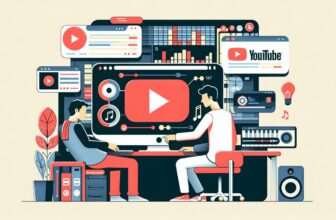How to Make a Music Video – The Ultimate Guide (2024)
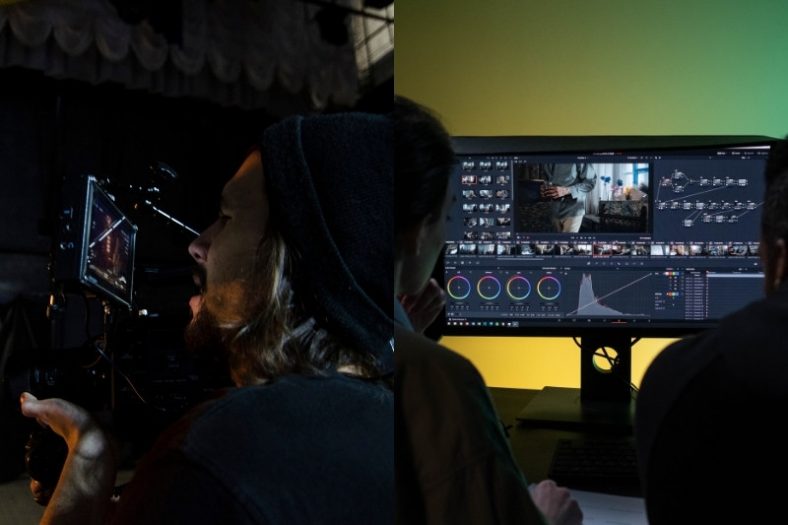
Ever since the 80s, music videos have become necessary for any band or artist hoping to gain popularity. From TV to streaming services like YouTube and Vevo, music videos help artists promote their music.
Audio-visual arts have become more accessible to the general audience in today’s entertainment business. Music videos are no exception to this. Music videos serve the same purpose as concerts that use lasers, projection, and light to support the live performance and entice the audience.
Of course, there are many different types of music videos. Each of them serves a different purpose; the general idea is to make the listener pay attention and zero in on the music and the video.
Contents
Types Of Music Videos
There are many types of music videos, such as those based on performance, narrative, concept, animation, and lyric music videos. Let’s take a look at each and see what falls under the scope of a particular type of music video.
Performance Music Videos
Performance music videos are the most common music videos. They feature an artist or band performing to the camera, and the aim is to concentrate on the artists and convey them uniquely.
Many performance music videos are creative to the point of recording the artists in a zero-gravity plane or filming the whole music video underwater. There’s no end to the creative ideas for a performance music video. However, the idea is the same – the artists are the centerpiece of the music video.
A good example of a performance music video is “Best Of You” by Foo Fighters. It features the whole band performing the song.
Narrative Music Videos
The best way to explain narrative music videos is that they often seem like short films that have a beginning, middle, and end. The only thing that might be different from a short film is that the content of the narrative music video should follow the song’s content.
There are many approaches you can take when writing a narrative music video, and the main thing to focus on is how you build the story of the music video. Some popular theories about building stories are ‘Levi-Strauss’s Theory’ and ‘Todorov’s Narrative Theory.’
One of the best narrative music videos has to be “Goliath” by WOODKID, which charts an oil refinery worker’s discovery that he is enabling something monstrous, which is breathtaking.
Concept Music Videos
At first glance, concept music videos may look similar to narrative music videos, but there is one colossal rule that applies here: free artistic expression.
Concept music videos do not have to follow the traditional rules of story building, and they can be created in many different ways. CGI, stop-motion animation, 2D animation, and live-action recording are just the tip of the iceberg for artistic expression in concept music videos.
An excellent example of a concept music video is “Otherside” by Red Hot Chili Peppers. With its striking style and scenery, it’s considered one of their best music videos.
Animated Music Videos
With animation software becoming more accessible, animated music videos are becoming more and more popular. Be it 3D animation, 2D animation, stop-motion animation, or visual effects added on top of tracked live-action shots, it looks cool and makes the whole experience more immersive.
Unfortunately, Animated music videos take a lot of time to be made and might cost quite a lot depending on if you’re hiring one artist to do the work or a whole animation studio.
3D animated music videos have an entire pipeline of workflow: from pre-production (idea, story, storyboard, animatic) to production (layout, R&D, modeling, texturing, rigging, animation, VFX, lighting, and rendering), and post-production (compositing, motion graphics, color grading, and final output). When creating a music video of this type, the cost and time add up quickly.
A great example of animated music videos is: “Do the Evolution” by Pearl Jam. The music video is exciting, depressing, funny, hideous, and beautiful.
Lyric Music Video
Lyric music videos have gained popularity lately and are often more budget-friendly. The idea is simple – The lyrics are displayed for the viewer/listener, with the main focus being the song only.
Generally speaking, a music video is made to promote an artist/musician or a band, while the lyric videos promote the song. There are also music/lyric video fusion examples where you don’t have to pick between the two. An animated loop, photo, or 3D animation loop is often played in these videos with animated typography on top of them.
A good example of a lyric music video is “Dirty Paws” by Of Monsters And Men – a 2D animated loop, followed by the lyrics animated as captions.
How to Make a Music Video (step-by-step guide)
Let’s take a look at the step-by-step guide on how to approach making a music video. Here is a youtube video that can help you with pre-production and has good examples of a storyboard and shot lists.
1. Develop the concept
One of the mistakes that beginner filmmakers make is that they don’t spend enough time in pre-production. This includes everything from talking about the idea with the artist or band members to watching reference videos and general brainstorming.
Having a clear and concise idea at the beginning of the process makes up for a lot of time spent correcting and starting over with filming due to poor communication. This doesn’t just prolong the schedule, it also costs more.
2. Consider your budget and technical skills
A music video’s budget and technical requirements must be considered during the pre-production process. Some locations and licenses you might need for filming can cost quite a lot, and often, they are not that necessary to serve the story.
The main thing to consider is writing your narrative with your budget and technical skills in mind. You might want to film an actor on a green screen and create a 3D environment as if the actor is floating in space while singing. That sounds cool, but if the visual effects, rendering, and compositing are out of your budget, you might want to reconsider the idea and start from scratch.
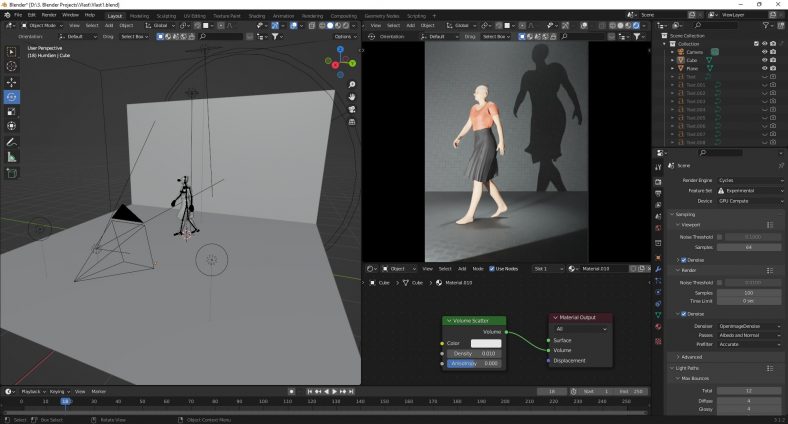
3. Location scouting
Location scouting is finding real places to serve as the fictional locations described in a film’s screenplay. In music videos, the right filming site should always support the narrative.
While scouting for a location, things to keep in mind are distance, permissions, cost, and logistics. Locations may vary between interior scenes and exterior scenes. For some places, a permit is needed for filming, so you would want to consult with local authorities if that’s the case.
4. Plan the shoot and get a crew
I’ve already mentioned how important pre-production is, and planning for a shoot is a part of the pre-production process. Some of the tools that help plan the shoot are storyboards and shot lists.
There are many online tools to help you create storyboards and shot lists and even take notes, so you know exactly what to do on-site. Know every shot and include the technical details such as camera settings, lights, etc.
Finding and hiring film crew has become more accessible today. You have a lot of online websites to help you find a film crew and hire people for every aspect of your production.
5. Equipment
There is a lot to consider when discussing equipment for filming a music video. First, you need to figure out how many cameras you need. Most of the time, one camera will do the job. But, if you plan on getting aerial footage to introduce the environment in the music video, you will need a drone.
There are a lot of stores and companies that let you rent video equipment, so if you don’t have your own, renting is the way to go. Lights are also essential to portray the story better, which brings us to our next point.
6. Get proper lighting
Lighting allows you to set the mood for the music video. One of the most important things is getting the lighting right. There is a lot of science involved in this one, but it all comes down to what you are trying to accomplish with it and how you want to set the mood.
Having proper lighting also helps in the post-production process of color correction and color grading of the music video. So, make sure not to use some cheap lights while filming; also, hiring a professional lighting person (technician) will go a long way.
7. Stock footage
One option to consider is using stock footage. There are a lot of websites that offer both royalty-free and paid stock footage. Going for stock footage will often result in a more cost-effective way to display some location or set the environment.
Some websites that offer free stock video clips are Pexels and Videvo. Make sure to check the licensing in any case if you’re going for the free route to avoid royalties and copyright laws. Also, keep in mind that stock photos uploaded to free stock video sites might not be properly vetted and might be in violation of copyright, so if you want to stay on the safe side, then buy stock footage.
8. Start filming
Let’s move on to the production part. Even though you planned everything in pre-production, with a shot-list in one hand and storyboard in the other, some things still change. What that means is to try not to limit yourself by everything you have written down before shooting. All of the stuff we do in pre-production is only there to help us during production, and it’s not set in stone.
“Less is more” might be an overused phrase, but cliches are cliches for a reason, which is true in filmmaking as it is everywhere else. Avoiding complex stuff and keeping it simple will result in better music videos.
9. Editing stage
The editing stage is where you combine all of the shots. Suppose you are making a performance music video. In that case, this is where you should become familiar with the footage and the song and create a multi-camera sequence to synchronize the footage with the master audio file (audio track).
If this sounds a bit too complicated, remember that video editing software like Adobe Premiere Pro, DaVinci Resolve, and Final Cut Pro do most of the work for you, even iMovie is a decent software. If you are looking for free editing software, DaVinci Resolve has a great free version that only limits the resolution and some effects that you may not end up using anyway.
The main thing to remember while editing is that the video serves the music in this case, and generally, it should keep up with the song’s tempo. There are many different ways to edit a music video, but oftentimes, a simple cut on the beat is a great way to go.
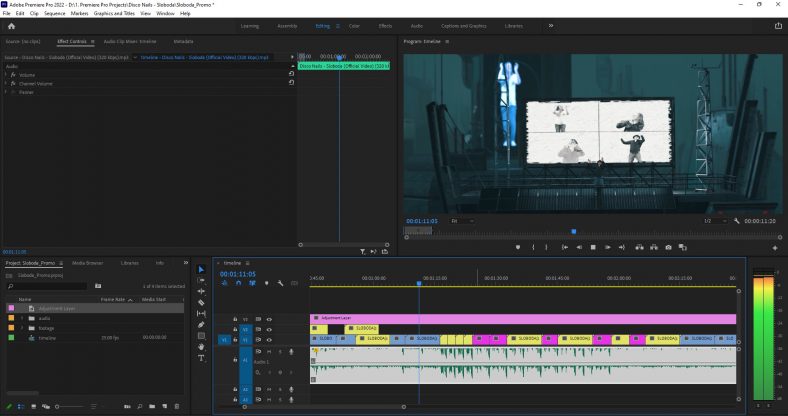
10. Compositing and color grading
At this stage, you are ready to do all the compositing work if you have VFX or animation in your music video. The final step is to do the music video’s color correction and color grading.
A colorist uses color grading to make technical and creative changes. Color grading is where you start to create the final aesthetic of the music video. DaVinci Resolve is an industry-standard software for colorwork, even having the free version means that you have the most powerful tool for color grading.
Assessing the Budget and Technical Experience
Before starting with your music video, you have to assess the budget and figure out what technical experience you have. Generally, you should always create the concept of your music video around your budget and expertise.
Low-budget with minimal technical skills
A low-budget music video doesn’t mean that the music video has to be filmed on a lower resolution, or it shouldn’t be treated as a regular music video. There are quite a few differences that I’ll go over when planning to shoot a low-budget music video, and there are things to keep in mind during production.
First of all, cameras have become so powerful that you don’t even need a professional video camera to shoot a music video. A simple DSLR camera or your phone can do a decent job. Use whatever you have or something you can borrow from your family or friends.
Think about doing the whole pre-production yourself. It might take time, but it’s worth it. For the production part, you can find some aspiring video makers or students to help you out with filming the video. Also, I suggest looking at services like Fiverr and Upwork to find budget-friendly editors and colorists for the post-production.
There are a lot of creative low-budget music videos, and often limiting yourself with equipment can help you with the creative part. For instance, you don’t need to rent lights for a low-budget music video. If you film interior scenes, just place your talent close to a window and treat the window as a light source, or film all the scenes outside.
Mid-range budget with some knowledge about the subject
Mid-range budget for music videos is where you can use a more technical approach. You will want to rent a proper video camera and lights in this budget. Also, while in pre-production, there are many different types of shots/camera angles you can plan out with a mid-range budget.
You can also incorporate different techniques and gear to help you shoot. Gimbal systems have become quite affordable and are something to consider if you go for those shots.
The main thing here is that you don’t have to limit your concept and ideas because of the lack of equipment or crew; you have to limit your equipment and team to serve your idea and vision in the right way.
High-budget with good technical skills
When budget is not a problem, you solve many other problems by buying or renting the right equipment and crew. You don’t want to cut costs in the post-production stage. You can rent out a professional video camera and different dolly tracks or whatever you may need to gear up the camera during production.
The primary advice to give you here is that you want to hire professionals to do their job when the budget is not an issue. Communicate the ideas clearly and go for it. While doing the scripts and storyboards, you don’t have to think about if you need aerial shots; you can film all shots and then decide if you use them during editing.
Even a few VFX shots or animations are possible with a high budget for a music video, so that opens up a lot of different concepts and ideas that you can have since you are not limited by using a camera and a more traditional way of recording.
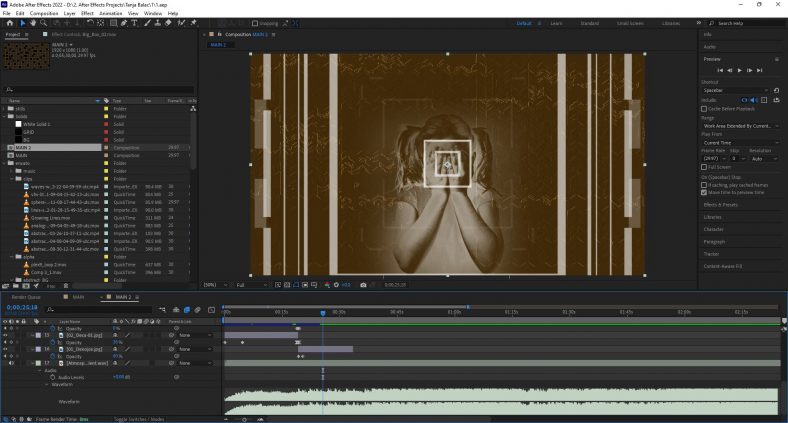
Professional Music Video
A professional music video is not a one-person job and often requires many different people with different skills to work together towards a common goal. The bare minimum of professionals you will need while creating a professional music video is a director, producer, director of photography, gaffer(chief lighting technician), talent, and a video editor.
An art director, set director, production sound mixer, choreographers, prop master, grip, wardrobe, costume, hair and make-up pros, and a separate crew of VFX supervisors and animators can all be found on a more established set.
While developing a concept for a professional music video, you don’t have to limit yourself to anything, and the only limitation here is your creativity. There should also be a budget set aside for promotions and marketing of the music video.
How Much Do Music Directors Make?
Music directors’ salary depends on which stage of their career they are at and their experience. The salary range for music video directors runs from $15,000 to $180,000. Though this is not only based on experience and the budget of a band/label that produces videos, it is also very based on geographical region.
How Much Does a Music Video Cost?
Depending on the type of music video you decide to go for, it could cost almost nothing if you try to do it yourself, or it could cost upwards of $500,000 for a professional set, VFX, and talent. Cost quickly adds up when creating a concept for a music video, so it’s always good to set your budget before even starting with pre-production.
How to Break Through as a Music Video Director?
The best thing that you can do to break through is to have a good portfolio. Let your work speak for yourself and try to improve with every project you do. People are often afraid to experiment with something new, especially if that “something new” costs quite a lot, but it’s just something that you have to do to learn and progress. Eventually, you can be one of the most sought-after directors with hard work and dedication.
Conclusion
People often ask if they need to make a music video and if it’s worth the investment. The short answer is yes, and the long one is – it depends. Producing music videos is so accessible today that it definitely wouldn’t hurt your marketing strategy and get your music out there.
Nevertheless, music videos are in a pretty competitive market depending on music style (genre) and how big your band is. One thing is certain – fans appreciate a good music video, especially with the accessibility and rise of social media like Instagram, Facebook, etc.

